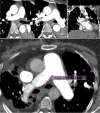Decreased Pulmonary Artery Bifurcation Angle: A Novel Imaging Criterion for the Diagnosis of Chronic Pulmonary Thromboembolism
- PMID: 35919084
- PMCID: PMC9339105
- DOI: 10.30476/IJMS.2021.88058.1926
Decreased Pulmonary Artery Bifurcation Angle: A Novel Imaging Criterion for the Diagnosis of Chronic Pulmonary Thromboembolism
Abstract
Background: Chronic pulmonary thromboembolism (CTEPH) is an unusual complication of acute pulmonary embolism (PE), which is now considered to be treatable. In modern multi-detector scanners, a detailed evaluation of pulmonary artery geometry is currently possible. This study aimed to evaluate the changes in pulmonary artery bifurcation angle (PABA) in the follow-up computed tomography angiography (CTA) of patients with acute PE.
Methods: In this cross-sectional study, the records of two tertiary-level academic hospitals were gathered from 2012 to 2019. Pulmonary artery (PA) bifurcation angle and diameter were measured. Chi square test, independent samples t test, Mann-Whitney, and Pearson's tests were employed to compare data. To evaluate the cut-off point, we utilized receiver operating characteristic (ROC) curve analysis. The accuracy, sensitivity, and specificity of pulmonary artery bifurcation angle changes were calculated. A P value <0.05 was considered to be significant.
Results: Forty-six patients were included in the study. No significant differences were found between patients with and without CTEPH, and PABA in the dimeters of PA trunk, right PA, and left PA in the first CTA images (P values of 0.151, 0.142, 0.891, and 0.483, respectively), while in the secondary CTA, the mean PABA was significantly smaller in patients with CTEPH (P=0.011). In the receiver operating characteristic (ROC) analysis, delta angle revealed an area under the curve of 0.745 and an optimal cutoff of 0, leading to a sensitivity of 64%, specificity of 87%, and accuracy of 76% for diagnosing CTEPH.
Conclusion: We showed a significant decrease in PABA in patients developing CTEPH. This parameter can be easily measured in lung CTA.
Keywords: Computed tomography angiography; Pulmonary artery; Pulmonary embolism.
Copyright: © Iranian Journal of Medical Sciences.
Figures



Similar articles
-
A septal angle measured on computed tomographic pulmonary angiography can noninvasively estimate pulmonary vascular resistance in patients with chronic thromboembolic pulmonary hypertension.J Thorac Imaging. 2012 Sep;27(5):325-30. doi: 10.1097/RTI.0b013e3182541142. J Thorac Imaging. 2012. PMID: 22562020
-
Are pulmonary artery pulsatility indexes able to differentiate chronic pulmonary thromboembolism from pulmonary arterial hypertension? An echocardiographic and catheterization study.Heart Vessels. 2011 Mar;26(2):176-82. doi: 10.1007/s00380-010-0044-x. Epub 2010 Oct 16. Heart Vessels. 2011. PMID: 20953614
-
Cardiovascular parameters of computed tomographic pulmonary angiography to assess pulmonary vascular resistance in patients with chronic thromboembolic pulmonary hypertension.Int J Cardiol. 2013 Apr 15;164(3):295-300. doi: 10.1016/j.ijcard.2011.07.019. Epub 2011 Aug 5. Int J Cardiol. 2013. PMID: 21820745
-
Value of 18F-FDG PET/CT in differentiating malignancy of pulmonary artery from pulmonary thromboembolism: a cohort study and literature review.Int J Cardiovasc Imaging. 2019 Jul;35(7):1395-1403. doi: 10.1007/s10554-019-01553-5. Epub 2019 Feb 12. Int J Cardiovasc Imaging. 2019. PMID: 30747369 Review.
-
Acute Pulmonary Embolism and Chronic Thromboembolic Pulmonary Hypertension: Clinical and Serial CT Pulmonary Angiographic Features.J Korean Med Sci. 2022 Mar 14;37(10):e76. doi: 10.3346/jkms.2022.37.e76. J Korean Med Sci. 2022. PMID: 35289137 Free PMC article. Review.
Cited by
-
The Importance of Topographical Recognition of Pulmonary Arteries in Diagnostics and Treatment of CTEPH, Based on an Analysis of a Dissected Case Model-A Pilot Study.Diagnostics (Basel). 2024 Aug 3;14(15):1684. doi: 10.3390/diagnostics14151684. Diagnostics (Basel). 2024. PMID: 39125560 Free PMC article.
-
[Fluid-solid coupling model and analysis on pulse wave propagation properties of iliac artery].Sheng Wu Yi Xue Gong Cheng Xue Za Zhi. 2024 Apr 25;41(2):351-359. doi: 10.7507/1001-5515.202306004. Sheng Wu Yi Xue Gong Cheng Xue Za Zhi. 2024. PMID: 38686417 Free PMC article. Chinese.
References
-
- Nishiyama KH, Saboo SS, Tanabe Y, Jasinowodolinski D, Landay MJ, Kay FU. Chronic pulmonary embolism: diagnosis. Cardiovasc Diagn Ther. 2018;8:253–71. doi: 10.21037/cdt.2018.01.09. [ PMC Free Article ] - DOI - PMC - PubMed
Publication types
MeSH terms
Substances
LinkOut - more resources
Full Text Sources
Medical
